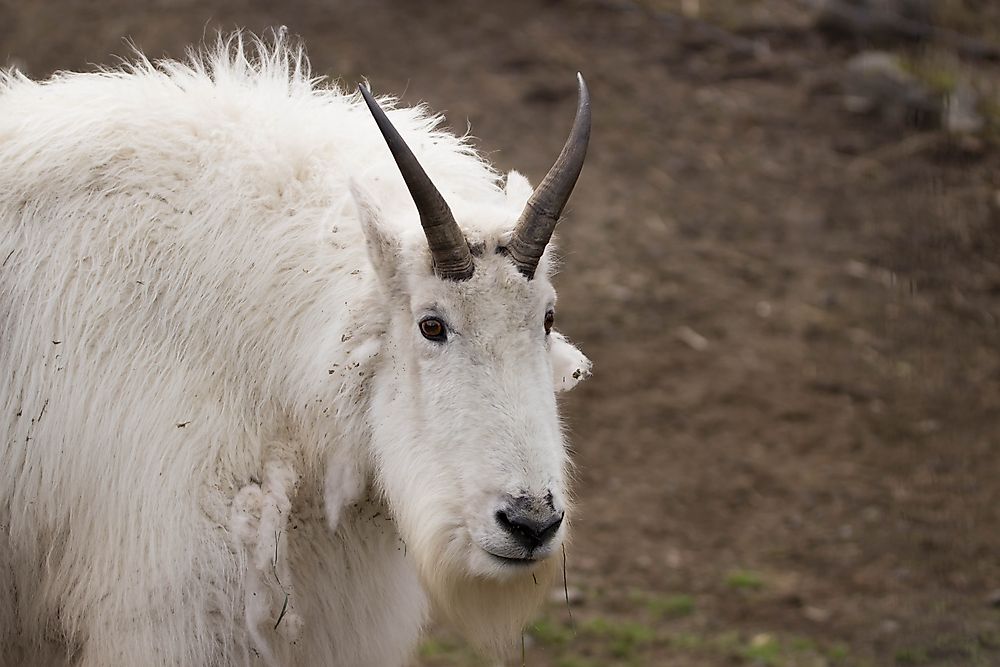Mountain Goat Facts: Animals of North America

5. Physical Description
The mountain goat, or what’s scientifically known as the Oreamnos americanus, is also commonly referred to as the Rocky Mountain goat. It is very commonly found thriving in the mountains, cliffs and cold highlands of North America. Mountain goats are characterized by their large hooves, elongated faces, stubby tails, and black horns. Beard-like hair on the chins of both the male and female members of the species are present, along with a thick, wooly, fur covering that keeps them warm during winter, especially for those living in highly elevated mountain areas. Mountain goats are well equipped for scaling rocky and steep ledges, having powerful, muscular forequarters. Their hooves are not only pliable, but are also supported with tough, rubbery pads as well, making their feet well equipped for dealing with craggy rocks.
4. Diet
The Mountain, or Rocky Mountain, goat, when living in the wild or in the cold grasslands or cliffs of North America, has been observed to thrive rather well upon a mostly green diet consisting of lichens, shrubs, sedges, grasses, herbs, fern mosses and leaves. These are sourced from plants that grow on the highly elevated habitat of these animals. These surefooted goat-antelopes are avid herbivorous browsers who spend the majority of their time picking for food in the majestic alpine environment of North America’s upper Rockies. When grown for use as livestock, they may be mostly fed alfalfa and grain, as well as a variety of vegetables, grasses and fruits.
3. Habitat and Range
The population of mountain goats in North America is estimated to stand at around 100,000 members. They inhabit the Pacific coastal ranges and Rocky Mountains of North America, as well as the southwestern regions of Alaska. These include the Cascade Range and other mountainous ranges of the Western Cordillera from Idaho, Washington and Montana, northward into Alberta, British Columbia, and the southern portions of Yukon as well. As an introduced species, the mountain goat is also to be found in the states of Colorado, Nevada, Oregon, Utah and the hilly Olympic Peninsula of Washington. While primarily an alpine species, these goat-antelopes are sometimes found migrating to sea level in coastal areas, as well as some forested inland regions, in search of salt and other minerals.
2. Behavior
Mountain goats seem to thrive when living in herds, and may be considered very active according to the season of the year. During summer, they migrate to salt licks, while grazing all throughout the day and night. The males of the species ('billies') tend to live mostly alone, or with one or two other males, while their females (also known as 'nannies') live with their 'kids' (juvenile goats). Nannies are very aggressive when it comes to protecting their kids, their territory, and their food sources alike. Meanwhile, the males will often fight each other with their horns for the privilege of reproducing with select females. Like most animals, mountain goats fight each other for a variety of reasons, which can sometimes lead to injury or death, although the latter consequence does not happen very often.
1. Reproduction
The mating season for mountain goats usually lasts in the months of November and December. They will live for about 12 to 15 years when in the wild while, in captivity, they may live for up to 20 years. Sexual maturity for mountain goats is achieved at around 2 and a half years of age, with mating rituals being displayed by both the billies and the nannies of the species. These include very specific, sometimes even peculiar, behaviors, such as the digging of pits, fighting between males, and staring at the nannies for extended periods of time.











